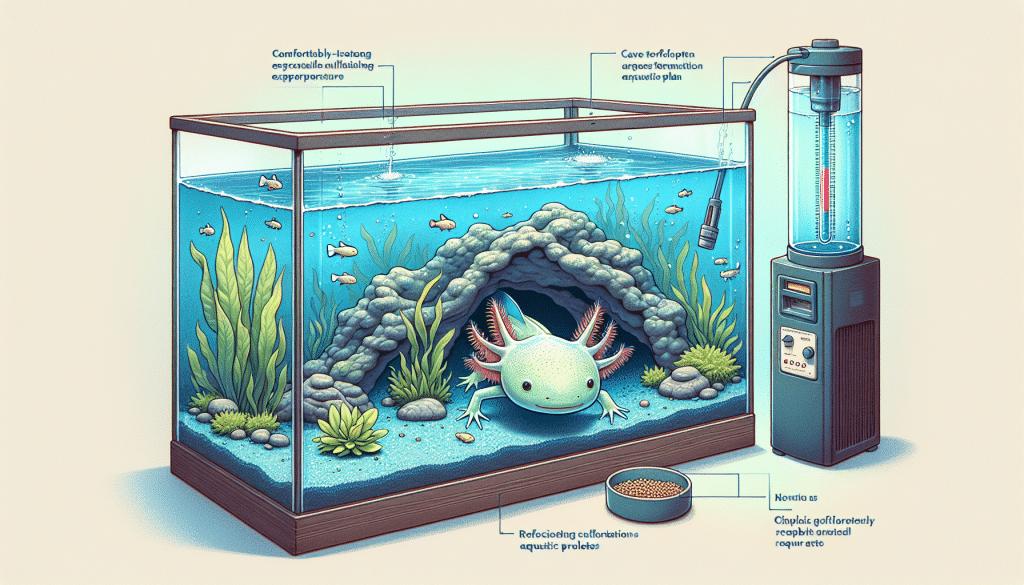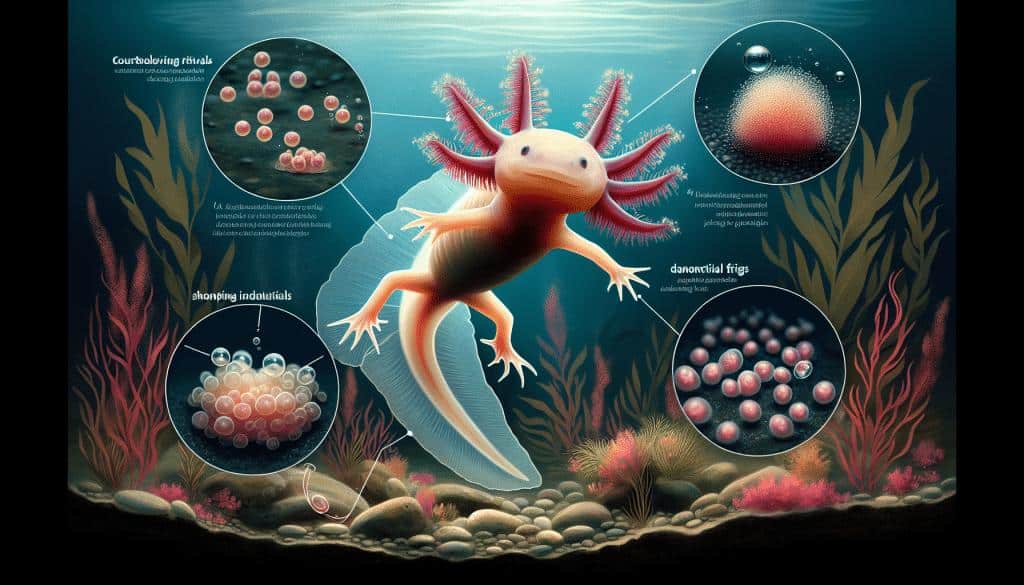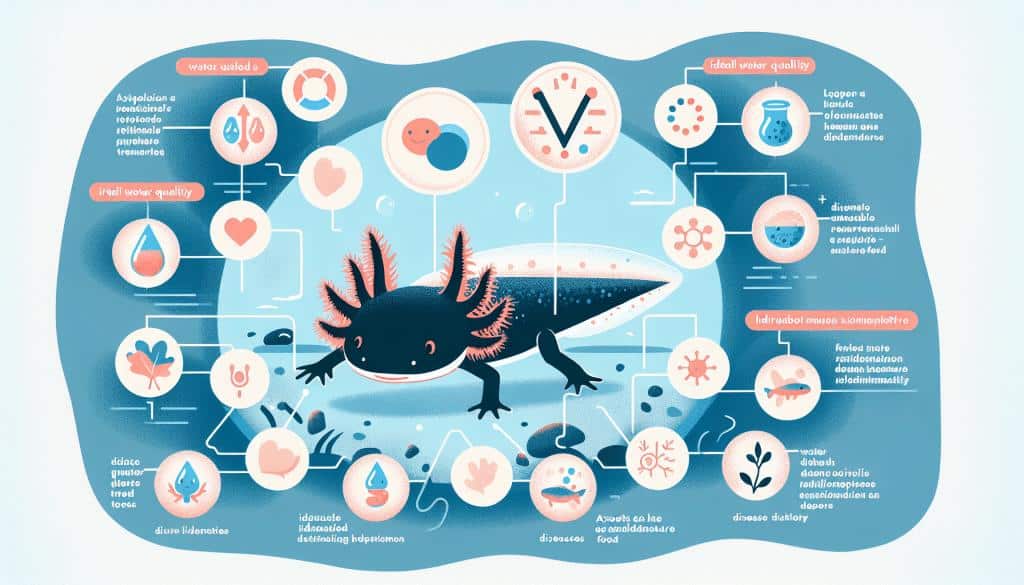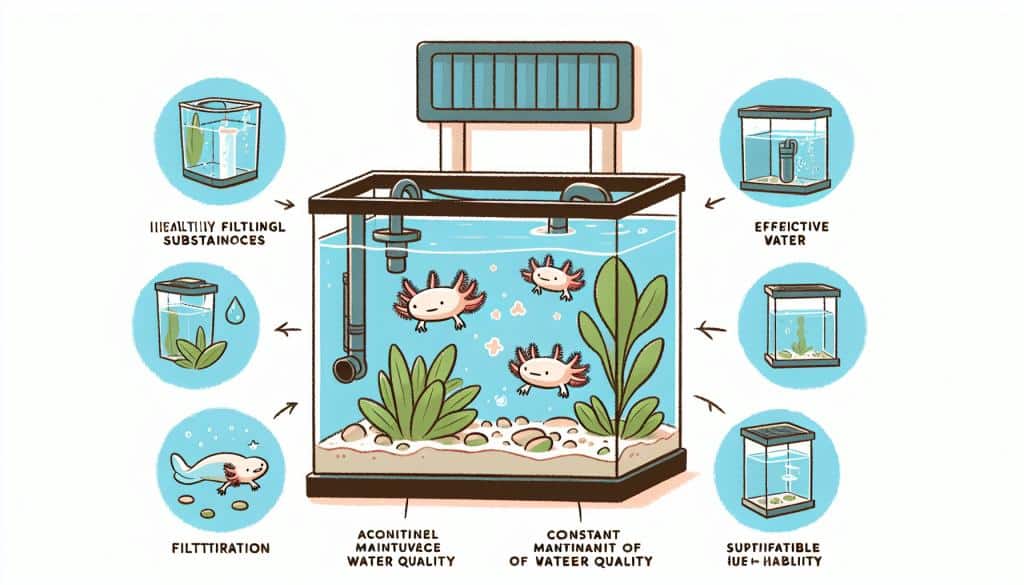You think you know what it takes to keep an axolotl happy in their tank? Well, think again. Meeting the tank requirements for these elusive creatures is no leisurely task. From water temperature to tank size, every detail needs to be meticulously calculated and implemented. One wrong move and you could be facing a sickly axolotl or worse, death. So if you think you’re ready to take on the challenge, strap in and prepare for an angry reality check on how to meet axolotl tank requirements.

Understanding Axolotl Biology and Habitat
Adaptations for Aquatic Life
Axolotls, also known as Mexican walking fish, are fascinating amphibians that have adapted to an entirely aquatic lifestyle. Unlike most amphibians, axolotls do not undergo metamorphosis and remain permanently in their larval form. They possess several adaptations that allow them to thrive in water. Their external gills on the sides of their heads enable them to extract oxygen from the water, while their lungs are only used for respiration in emergencies or when oxygen levels in the water are low. Axolotls also have four limbs with long digits, which aid in swimming and navigating their aquatic environment.
Natural Habitat and Conditions
Axolotls are native to the ancient water bodies of Xochimilco and Chalco in Mexico. These habitats are characterized by slow-moving, shallow, and murky waters, with plenty of vegetation and hiding places for the axolotls. The water in these habitats is typically cool, with temperatures ranging from 57 to 68 degrees Fahrenheit (14 to 20 degrees Celsius). The pH of the water is slightly acidic, ranging from 6.5 to 7.5, and the water hardness varies between 75 and 175 ppm. It is crucial to replicate these natural conditions in captivity to ensure the well-being of axolotls.
Behavioral Needs of Axolotls
Axolotls are known for their solitary and nocturnal nature. They are generally inactive during the day and become more active in the evening and at night. Providing them with hiding places, such as caves or plants, is essential to meet their behavioral needs. Axolotls are also prone to stress, so it is crucial to create a calm and peaceful environment for them. Excessive noise, bright lights, or sudden movements can cause them distress. Monitoring their behavior and ensuring that their habitat meets their behavioral needs is crucial for their overall health and well-being.
Aquarium Size and Type
Recommended Tank Size for Axolotls
Providing an adequate tank size is crucial for the welfare of axolotls. As fully grown adults can reach lengths of up to 12 inches (30 centimeters), a minimum tank size of 20 gallons is recommended for a single adult axolotl. For multiple axolotls or larger individuals, a larger tank is necessary to ensure they have sufficient space to swim and explore their environment comfortably. It is important to consider their long bodies and provide ample swimming space to prevent injury or stress.
Glass vs. Acrylic Tanks
When selecting a tank for axolotls, both glass and acrylic tanks are suitable options. Glass tanks are often favored due to their durability and resistance to scratches. However, acrylic tanks offer the advantage of being lighter and less prone to shattering if accidentally dropped. Whichever material you choose, ensure that the tank is sturdy and specifically designed to hold water. It is essential to select a tank with a secure lid to prevent escape and protect the axolotls from potential hazards.
Shape and Design Considerations
Axolotls prefer tanks with a larger surface area rather than tall tanks with limited swimming space. A rectangular or square-shaped tank is ideal as it maximizes the available space for the axolotls to swim and provides a more natural swimming experience. Additionally, a tank with smooth edges and minimal decorations inside is recommended to prevent any injuries or damage to their sensitive skin. Avoid tanks with sharp corners or rough surfaces that could potentially harm the axolotls.

Water Quality and Parameters
Ideal Temperature Range
Maintaining the correct water temperature is crucial for the health and well-being of axolotls. The ideal temperature range for axolotls is between 60 to 68 degrees Fahrenheit (15 to 20 degrees Celsius). Higher temperatures can lead to stress, while lower temperatures can significantly slow down their metabolism and impair their immune system. To achieve the desired temperature, a reliable aquarium heater or chiller may be necessary, depending on the room temperature and climate.
pH and Hardness Requirements
Axolotls are adapted to slightly acidic water conditions, with a recommended pH range of 6.5 to 7.5. Testing the water regularly with a reliable pH test kit is essential to ensure that the pH remains within the suitable range for axolotls. Additionally, the water hardness should be between 75 and 175 ppm (parts per million). Water hardness can be adjusted using appropriate additives or by using filtered water during water changes.
Nitrogen Cycle Management
Understanding and managing the nitrogen cycle in your axolotl tank is vital for the well-being of your pets. The nitrogen cycle involves the conversion of toxic ammonia, produced from axolotl waste, into less harmful nitrites and then nitrates. Beneficial bacteria naturally occur in the tank and help break down these nitrogen compounds. To establish a healthy nitrogen cycle, it is crucial to monitor the levels of ammonia, nitrites, and nitrates using reliable test kits. Regular water changes and the use of appropriate filtration systems aid in maintaining optimal water conditions.
Filtration Systems
Types of Filters Suitable for Axolotl Tanks
Axolotls produce a significant amount of waste, and a suitable filtration system is necessary to maintain clean and healthy water conditions. There are several types of filters suitable for axolotl tanks, including sponge filters, canister filters, and hang-on-back filters. Sponge filters are often recommended for axolotl tanks as they provide gentle water movement, ensure biological filtration, and are safe for the axolotls’ sensitive gills. Canister filters and hang-on-back filters can also be used, but care must be taken to adjust the flow rate to avoid excessive water movement and stress for the axolotls.
Filter Maintenance Tips
Regular cleaning and maintenance of the filtration system are essential to ensure its efficiency. It is recommended to clean the filter media by rinsing it in dechlorinated water to remove any debris and accumulated waste. Avoid using tap water or abrasive materials that could potentially harm the beneficial bacteria present in the filter media. Additionally, it is crucial to regularly replace any worn-out or damaged filter components to maintain optimal filtration performance.
Balancing Flow Rate with Axolotl Comfort
Axolotls prefer calm and slow-moving waters, and excessive water flow can cause stress and discomfort. When selecting or adjusting your filtration system, consider the flow rate and ensure it is suitable for axolotls. You can reduce the flow rate by using a pre-filter sponge or adjusting the output flow direction. It is beneficial to observe the behavior of your axolotls and make adjustments accordingly to provide them with a comfortable and stress-free swimming environment.

Substrate and Decoration
Choosing the Right Substrate
The substrate chosen for an axolotl tank should be safe, non-abrasive, and non-toxic. Ideally, a bare-bottom tank is recommended as it simplifies cleaning and prevents the risk of impaction from accidentally ingesting substrate. However, if you prefer to have substrate in the tank, options such as fine sand or smooth river rocks can be considered. Avoid using gravel or any substrate with small particles that can be accidentally swallowed by the axolotls.
Safe Decorations and Plants
Axolotls appreciate a well-decorated tank that provides them with hiding places and stimulates their natural instincts. When selecting decorations and plants, ensure they are safe for axolotls. Avoid decorations with sharp edges or small decorative elements that could injure the axolotls. Live or artificial plants should be soft and non-toxic, with no sharp edges or potentially harmful substances. It is important to always thoroughly rinse any decorations or plants before adding them to the tank to remove any potential chemicals or debris.
How to Create Hiding Places
Axolotls are secretive creatures that require hiding places to feel secure and reduce stress. Providing caves, PVC pipes, or hollow logs gives them a sense of security and allows them to retreat when they feel the need to hide. Arrange these hiding places in various areas of the tank to create a natural-looking environment. The axolotls will appreciate having options to choose from, providing them with a sense of control over their surroundings.
Lighting Requirements
Importance of Proper Lighting
Lighting plays a vital role in maintaining the natural day and night cycle for axolotls. While they are primarily nocturnal, providing a regular light cycle helps regulate their behavior and overall health. Additionally, proper lighting enhances the aesthetic appeal of the tank, showcasing the vibrant colors of the axolotls and the tank decor. Investing in suitable lighting helps create a visually pleasing environment while maintaining the well-being of the axolotls.
Lighting Options for Axolotls
When selecting lighting for your axolotl tank, it is important to consider their sensitivity to bright lights. LED lights are a popular choice as they offer a wide range of customizable lighting options, including adjustable intensity and color settings. It is essential to avoid intense or direct lighting that may cause stress or harm to the axolotls’ sensitive skin and eyes. Opt for lighting options that provide a gentle and diffused light, mimicking the natural lighting they would encounter in their native habitat.
Creating a Light Schedule
Establishing a proper light schedule helps simulate the natural day and night cycle for axolotls, promoting their physical and behavioral well-being. Aim to provide around 12 hours of light and 12 hours of darkness, mimicking a natural light cycle. Using a timer for your lighting system ensures consistency and automates the light schedule, making it easier to maintain a regular routine for your axolotls.
Tank Temperature Control
Using Heaters and Chillers Appropriately
Maintaining a stable water temperature within the recommended range is crucial for axolotls. Depending on the room temperature and climate, a heater or chiller may be necessary to achieve and maintain the desired temperature. Heaters are typically used to warm the water during colder seasons or in cooler climates, while chillers are used to cool the water in warmer environments. It is important to select reliable and adjustable temperature control equipment and regularly monitor the water temperature to ensure it remains within the optimal range for axolotls.
Monitoring and Maintaining Stable Temperatures
Regular monitoring of the water temperature is essential to ensure the well-being of axolotls. Invest in a reliable aquarium thermometer and check the temperature daily or as recommended for your specific setup. Sudden temperature fluctuations and extreme temperature variations can be detrimental to axolotls. It is important to avoid exposing them to drastic temperature changes, as it can cause stress, weaken their immune system, and even lead to fatal consequences. Maintaining a stable and consistent water temperature is crucial for their health and overall vitality.
Signs of Temperature Stress in Axolotls
Axolotls are highly sensitive to temperature changes, and it is essential to monitor their behavior and physical condition for any signs of temperature stress. Common indicators of temperature stress include increased lethargy, loss of appetite, abnormal swimming behavior, and changes in skin coloration. If you observe any of these signs, it is recommended to check the water temperature immediately and make any necessary adjustments to provide a more suitable environment for your axolotls.
Feeding and Nutrition
Axolotl Diet Overview
Feeding axolotls a balanced and appropriate diet is crucial for their overall health and growth. As carnivorous amphibians, axolotls primarily consume small invertebrates and larvae in the wild. In captivity, they can be fed a diet of commercially available axolotl pellets or live foods such as bloodworms, brine shrimp, or blackworms. It is important to provide a variety of foods to ensure they receive all the essential nutrients they need for optimal health and development.
Feeding Frequency and Amount
Determining the appropriate feeding frequency and amount depends on the size and age of the axolotls. As a general guideline, juvenile axolotls should be fed once a day, while adult axolotls can be fed every other day or three times a week. Monitor their feeding response and adjust the quantity accordingly to prevent overfeeding, which can lead to obesity and health issues. It is essential to remove any uneaten food promptly to maintain water quality and prevent contamination.
Nutritional Supplements
In addition to a well-rounded diet, axolotls may benefit from occasional nutritional supplements. Calcium supplementation can promote healthy bone and shell development, especially for axolotls housed with calcium-dependent aquatic plants or shells. Commercially available reptile calcium powders can be dusted onto live foods before feeding. However, it is crucial to consult with a knowledgeable veterinarian or axolotl expert to ensure any supplements are appropriate and used in moderation.
Water Changes and Maintenance
Routine Water Change Schedule
Maintaining clean and quality water is essential for the well-being of axolotls. Regular water changes help remove accumulated waste, excess nutrients, and potential toxins from the tank. As a general guideline, perform a partial water change of 20-30% every week to keep the water parameters stable and ensure good water quality. Be sure to use dechlorinated water that is at a similar temperature to the tank to minimize stress on the axolotls.
Siphoning Techniques for Waste Removal
During water changes, siphoning or vacuuming the substrate is crucial to remove excess waste and debris. Gently insert the siphon into the substrate, taking care not to disturb the axolotls or damage any decorations. Siphon the water out, directing the flow to remove any visible waste or uneaten food. It is important to avoid removing all of the beneficial bacteria present in the substrate, as they aid in maintaining the nitrogen cycle.
Maintaining Cleanliness and Preventing Algae Growth
To prevent excessive algae growth and maintain a clean environment, regular maintenance tasks are necessary. Regularly clean the glass or acrylic surfaces of the tank to remove algae buildup using an aquarium-safe algae scraper or sponge. Avoid using any abrasive materials or chemicals that could harm the axolotls or compromise the water quality. Additionally, monitor the lighting duration and intensity, as excessive lighting can contribute to algae growth. Consider adding a few algae-eating snails or shrimp to help control algae naturally.
Acclimating Your Axolotl to the Tank
Proper Acclimation Procedures
When introducing axolotls to their new tank, it is crucial to acclimate them properly to minimize stress and ensure a successful transition. Float the bag containing the axolotl in the tank for approximately 15-20 minutes to allow the water temperature to equalize. Gradually add small amounts of water from the tank into the bag at regular intervals to acclimate the axolotl to the tank’s water chemistry. Finally, gently release the axolotl into the tank, avoiding sudden movements or exposing it to bright lights.
Quarantine Process for New Arrivals
Quarantining new axolotls before introducing them to an established tank is considered best practice. A separate quarantine tank allows for close monitoring and early detection of any potential health issues or diseases. Set up the quarantine tank with similar conditions as the main tank, including water temperature, quality, and hiding places. It is recommended to quarantine new arrivals for a minimum of two weeks, closely observing their behavior and appetite while monitoring for any signs of illness.
Introducing Axolotls to a Community Tank
Axolotls can coexist harmoniously with certain fish species or other compatible aquatic animals in a community tank under specific conditions. Careful consideration of the species’ compatibility, size, and feeding requirements is essential. Avoid housing axolotls with any fish that may nip at their gills or fin extremities. Additionally, ensure that the tank size and filtration capacity can accommodate the increased bioload from the additional inhabitants. Regular monitoring and observation are crucial to ensuring the well-being of all tank inhabitants and addressing any potential conflicts or stressors promptly.
In conclusion, meeting the tank requirements for axolotls is essential for their overall health and well-being. From providing the appropriate tank size and type to maintaining optimal water conditions, substrate, and decoration choices, lighting requirements, and feeding and acclimation procedures, every aspect of their care plays a vital role. By understanding axolotls’ unique biology and catering to their specific needs, you can create a suitable and enriching environment that allows these incredible amphibians to thrive in captivity.



